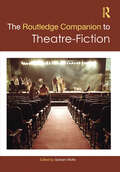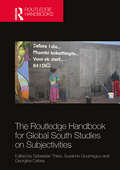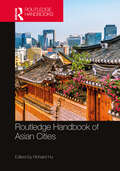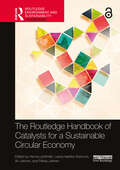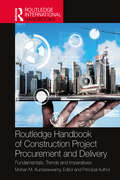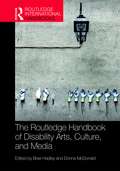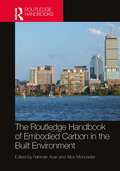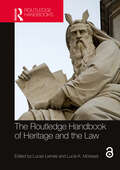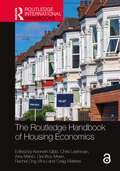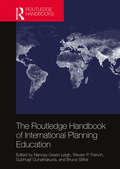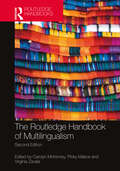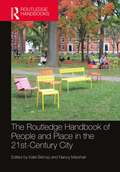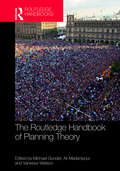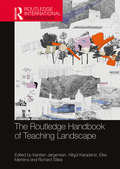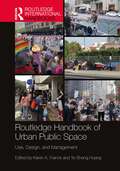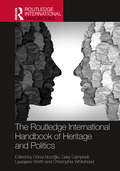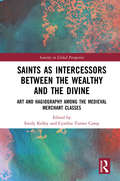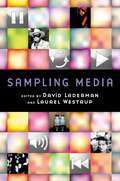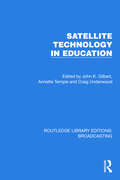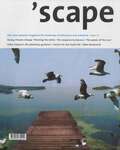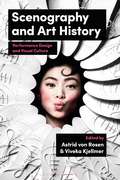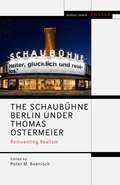- Table View
- List View
The Routledge Companion to Theatre-Fiction (Routledge Literature Handbooks)
Novelists have long been attracted to theatre. Some have pursued success on the stage, but many have sought to combine these worlds, entering theatre through their fiction, setting stages on their novels’ pages, and casting actors, directors, and playwrights as their protagonists. The Routledge Companion to Theatre-Fiction has convened an international community of scholars to explore the remarkable array of novelists from many eras and parts of the world who have created fiction from the stuff of theatre, asking what happens to theatre on the pages of novels, and what happens to novels when they collaborate with theatre. From J. W. Goethe to Louisa May Alcott, Mikhail Bulgakov, Virginia Woolf, and Margaret Atwood, some of history’s most influential novelists have written theatre-fiction, and this Companion discusses many of these figures from new angles. But it also spotlights writers who have received less critical attention, such as Dorothy Leighton, Agustín de Rojas Villandrando, Ronald Firbank, Syed Mustafa Siraj, Li Yu, and Vicente Blasco Ibañez, bringing their work into conversation with a vital field. A valuable resource for students, scholars, and admirers of both theatre and novels, The Routledge Companion to Theatre-Fiction offers a wealth of new perspectives on topics of increasing critical concern, including intermediality, theatricality, antitheatricality, mimesis, diegesis, and performativity.
The Routledge Handbook for Global South Studies on Subjectivities (Transdisciplinary Souths)
The Routledge Handbook for Global South Studies on Subjectivities provides a series of exemplary studies conjoining perspectives from Asian, African, and Latin American Studies on subjectivity in the Global South as a central category of social and cultural analysis. The contestation of the Northern myth of the autonomous subject—the dispositive that contests subject formation in the South by describing it as fragmented, incomplete, delayed or simply deviant, has been a cornerstone of theory production from the South over the years.This volume’s contributions offer an interdisciplinary and transarea dialogue, reframing issues of selfhood and alterity, of personhood, of the human, of the commons and contesting the North’s presumption in determining what kind of subjectivities abide by its norms, whose voices are heard, who is recognised as a subject, and, by extension, whose lives matter. In the context of the shifting dynamics of today’s manifold crises, they raise questions regarding how subjectivities act on or resist such forms of contestation, contingency, and indeterminacy.A major contribution to the growing body of scholarship on the Global South, this handbook will be an essential resource for students, scholars, researchers and instructors in literature, media and culture studies, sociology, anthropology, philosophy, law, politics, visual arts and art history.
Routledge Handbook of Asian Cities
This handbook provides the most comprehensive examination of Asian cities—developed and developing, large and small—and their urban development. Investigating the urban challenges and opportunities of cities from every nation in Asia, the handbook engages not only the global cities like Shanghai, Tokyo, Singapore, Seoul, and Mumbai but also less studied cities like Dili, Malé, Bandar Seri Begawan, Kabul, and Pyongyang. The handbook discusses Asian cities in alignment to the United Nations’ New Urban Agenda and Sustainable Development Goals in order to contribute to global policy debates. In doing so, it critically reflects on the development trajectories of Asian cities and imagines an urban future, in Asia and the world, in the post-sustainable, post-global, and post-pandemic era. Presenting 43 chapters of original, insightful research, this book will be of interest to scholars, practitioners, students, and general readers in the fields of urban development, urban policy and planning, urban studies, and Asian studies.
The Routledge Handbook of Catalysts for a Sustainable Circular Economy (Routledge Environment and Sustainability Handbooks)
This groundbreaking handbook leads the way in accelerating the transition to a sustainable circular economy by introducing the concept of a catalyst as a positive and enhancing driving force for sustainability. Catalysts create and maintain favourable conditions for complex systemic sustainability transition changes, and a discussion and understanding of catalysts is required to move from a linear economy to a sustainable and circular economy.With contributions from leading experts from around the globe, this volume presents theoretical insights, contextualised case studies, and participatory methodologies, which identify different catalysts, including technology, innovation, business models, management and organisation, regulation, sustainability policy, product design, and culture. The authors then show how these catalysts accelerate sustainability transitions. As a unique value to the reader, the book brings together public policy and private business perspectives to address the circular economy as a systemic change. Its theoretical and practical perspectives are coupled with real-world case studies from Finland, Italy, China, India, Nigeria, and others to provide tangible insights on catalysing the circular economy across organisational, hierarchical, and disciplinary boundaries.With its broad interdisciplinary and geographically diverse scope, this handbook will be a valuable tool for researchers, academics, and policy-makers in the fields of circular economy, sustainability transitions, environmental studies, business, and the social sciences more broadly.The Open Access version of this book, available at http://www.taylorfrancis.com, has been made available under a Creative Commons Attribution-Non Commercial-No Derivatives (CC-BY-NC-ND) 4.0 license.
Routledge Handbook of Construction Project Procurement and Delivery: Fundamentals, Trends and Imperatives
This Handbook provides the knowledge needed to design and deploy proactive construction project procurement and delivery systems based on essentials while addressing emerging construction industry imperatives in order to boost overall performance.Section 1 of the Handbook provides an overview, while Section 2 provides the fundamentals with fresh insights into the building blocks and trends in performance-linked procurement and delivery, including procurement strategies and commercial priorities, project briefs and management plans, design management, stakeholder management, risk management, ethics and professionalism, team building, information and knowledge management, digital aids, conflict, claims and dispute management, collaborative contracting, relationship-based teamworking and linking to built asset management.Section 3 explores and expands on specific trends, including sub-contractor selection, Building Information Modelling (BIM) in project cost management; off-site and modern methods of construction; 4IR/5IR technologies; and constructing for the circular economy, supply chain resilience and social value imperatives in this domain.While other books describe standard processes or focus on specific strategies such as design and build, target cost contracting or integrated project delivery, this Handbook presents the fundamentals of such processes and protocols together with invited specialist insights into growing trends and imperatives in holistic procurement and delivery. Those who could benefit from this Handbook include academics, researchers, postgraduate students, policy makers and administrators, managers in both public and private sectors involved with planning and overseeing construction project procurement and/or delivery and undergraduates looking for a balanced introduction and useful insights into what is critical to the success of construction projects, organisations and the industry itself.
The Routledge Handbook of Disability Arts, Culture, and Media
In the last 30 years, a distinctive intersection between disability studies – including disability rights advocacy, disability rights activism, and disability law – and disability arts, culture, and media studies has developed. The two fields have worked in tandem to offer critique of representations of disability in dominant cultural systems, institutions, discourses, and architecture, and develop provocative new representations of what it means to be disabled. Divided into 5 sections: Disability, Identity, and Representation Inclusion, Wellbeing, and Whole-of-life Experience Access, Artistry, and Audiences Practices, Politics and the Public Sphere Activism, Adaptation, and Alternative Futures this handbook brings disability arts, disability culture, and disability media studies – traditionally treated separately in publications in the field to date – together for the first time. It provides scholars, graduate students, upper level undergraduate students, and others interested in the disability rights agenda with a broad-based, practical and accessible introduction to key debates in the field of disability art, culture, and media studies. An internationally recognised selection of authors from around the world come together to articulate the theories, issues, interests, and practices that have come to define the field. Most critically, this book includes commentaries that forecast the pressing present and future concerns for the field as scholars, advocates, activists, and artists work to make a more inclusive society a reality.
The Routledge Handbook of Embodied Carbon in the Built Environment
This handbook explores the critically important topic of embodied carbon, providing advanced insights that focus on measuring and reducing embodied carbon from across the built environment, including buildings, urban areas and cities, and construction materials and components. Split into five distinct sections, international experts, researchers, and professionals present the recent developments in the field of embodied carbon from various perspectives and at different scales of material, building, and city. Following an introduction to the embodied carbon question, the chapters in Section 1 then cover the key debates around issues such as the politics of embodied carbon, links between embodied carbon and thermal mass, and the misuse of carbon offsets. Section 2 reviews the embodied carbon policies in a selected number of countries. Sections 3, 4, and 5 approach the topic of embodied carbon from urban-, building-, and material-scale perspectives, respectively, and use case studies to demonstrate estimation techniques and present opportunities and challenges in embodied carbon mitigation. This will be important reading for upper-level students and researchers in Architecture, Urban Planning, Engineering, and Construction disciplines. Presenting case studies of embodied carbon assessment, this book will also help practicing architects, engineers, and urban planners understand embodied carbon estimation techniques and different mitigation strategies.
The Routledge Handbook of Heritage and the Law (Routledge Handbooks on Museums, Galleries and Heritage)
The Routledge Handbook of Heritage and the Law sheds light on the relationship between the two fields and analyses how the law shapes heritage and heritage practice in both expected and unexpected ways.Including contributions from 41 authors working across a range of jurisdictions, the volume analyses the law as a transnational phenomenon and uses international and comparative legal methodologies to distil lessons for broad application. Demonstrating that the law is fundamentally a language of power and contestation, the Handbook shows how this impacts our views of heritage. It also shows that, to understand the ways in which the law impacts key aspects of heritage practice, it is important to tap into the possibilities of heritage as points of convergence of identity, struggles over resources, and the distribution of power. Framing heritage as a driver for legal engagement rather than a passive regulatory object, the book first reviews the legal fields or mechanisms that can shape action in the heritage field, then questions how these enable authority and give power to those who seize heritage, and finally envisions how the discussion between heritage and the law can lay new grounds in both those fields. Lifting the mists that often render the law opaque in heritage studies, the Handbook showcases the law as a medium through which the culture and the power of heritage are expressed and might be shared.The Routledge Handbook of Heritage and the Law presents a view of the law that is aimed at those who wish to reflect on how law has changed, or could change, what heritage is and how it can support social, cultural, local, or other development. It will be of interest to scholars, students, policymakers, and practitioners working in the areas of museum studies, heritage studies, and urban studies, as well as in cultural intervention and planning.Chapter 8 of this book is freely available as a downloadable Open Access PDF at http://www.taylorfrancis.com under a Creative Commons [Attribution-Non Commercial-No Derivatives (CC-BY-NC-ND)] 4.0 license
Routledge Handbook of High-Performance Workplaces (Transdisciplinary Workplace Research and Management)
This timely book focuses on an overview of the fundamentals behind high-performance workplaces underpinning occupants’ satisfaction, health, and productivity. To this end, it covers human, environmental, and organisational aspects proven to be of great relevance to the design of high-performance workplaces. Perhaps most significantly it looks at these characteristics both before and after the start of the COVID-19 pandemic. From the exodus from private offices to the rise of open-plan workplaces, where, how and when people work was changing rapidly pre-COVID. Post-COVID, pandemic-imposed restrictions banished workers from offices into their homes fast, leaving organisation scrambling to keep workers functioning away from HQ. After the immediate shockwaves set by the pandemic, workers and organisations have had the time to learn about positives and negative aspects of remote working with the vast majority now questioning the need to go back to HQ and the purpose of offices. In this book, the contributors share and discuss lessons learned from research conducted in workplaces pre- and post-2020 with a view of providing a clear picture about what high-performance workplaces are about, including the key drivers behind workers’ satisfaction, health, and productivity. This handbook builds on a programme of applied research conducted in workplaces led by the editors over the last decade which is aimed at understanding the synergies between the design, performance, and experience of spaces. It examines ergonomics, biophilic design, acoustics, indoor air quality, thermal comfort, diversity, leadership, psychological safety, culture, and much more. Research findings are presented side-by-side with case studies selected from the research database led by the editors. Industry experts add to the academic voice, reinforcing the authenticity of this book and its relevance to other stakeholders found outside the academic arena, including the property and design industry, students, government, and the community in general.The Open Access version of this book, available at http://www.taylorfrancis.com, has been made available under a Creative Commons Attribution-Non Commercial-No Derivatives (CC-BY-NC-ND) 4.0 license.
The Routledge Handbook of Housing Economics (Routledge International Handbooks)
The Routledge Handbook of Housing Economics brings together an international panel of contributors to present a comprehensive overview of this important field within economics. Housing occupies an increasingly central role in modern society, dominating consumer assets and spending, forming an important part of social policy and being a large enough market to impact the macroeconomy. This handbook tackles these themes, along with other critical issues such as intergenerational housing inequality and the efficiency and social justice of housing interventions.This volume is structured in four main parts. It starts with eight chapters in microeconomics and housing. This is followed by two shorter sections on macroeconomics and finance. The final main part of the book is concerned with eight chapters on policy dimensions. While many of the chapters are rooted in mainstream economics and finance applied to housing, there are also chapters stressing institutional, behavioural and political economy orientations, as well as those that explicitly challenge more mainstream accounts. The contributing authors are based in Europe, North America and Australia and all draw in international literature to provide state of the art reviews of their topics.This carefully curated handbook will be essential reading for advanced students, researchers and policy makers in housing economics, urban economics, urban planning, public economics and real estate economics and finance.
The Routledge Handbook of International Planning Education
The Routledge Handbook of International Planning Education is the first comprehensive handbook with a unique focus on planning education. Comparing approaches to the delivery of planning education by three major planning education accreditation bodies in the United States, Australia, and the United Kingdom, and reflecting concerns from other national planning systems, this handbook will help to meet the strong interest and need for understanding how planning education is developed and delivered in different international contexts. The handbook is divided into five major sections, including coverage of general planning knowledge, planning skills, traditional and emerging planning specializations, and pedagogy. An international cohort of contributors covers each subject’s role in educating planners, its theory and methods, key literature contributions, and course design. Higher education’s response to globalization has included growth in planning educational exchanges across international boundaries; The Routledge Handbook of International Planning Education is an essential resource for planners and planning educators, informing the dialogue on the mobility of planners educated under different national schema.
The Routledge Handbook of Multilingualism (Routledge Handbooks in Applied Linguistics)
The Routledge Handbook of Multilingualism provides a comprehensive survey of the field of multilingualism for a global readership and an overview of the research which situates multilingualism in its social, cultural and political context. This fully revised edition not only updates several of the original chapters but introduces many new ones that enrich contemporary debates in the burgeoning field of multilingualism. With a decolonial perspective and including leading new and established contributors from different regions of the globe, the handbook offers a critical overview of the interdisciplinary field of multilingualism, providing a range of central themes, key debates and research sites for a global readership. Chapters address the profound epistemological and ontological challenges and shifts produced since the first edition in 2012. The handbook includes an introduction, five parts with 28 chapters and an afterword. The chapters are structured around sub-themes, such as Coloniality and Multilingualism, Concepts and Theories in Multilingualism, and Multilingualism and Education. This ground-breaking text is a crucial resource for researchers, scholars and postgraduate students interested in multilingualism from areas such as sociolinguistics, applied linguistics, anthropology and education.
The Routledge Handbook of People and Place in the 21st-Century City
Increasing urbanization and increasing urban density put enormous pressure on the relationships between people and place in cities. Built environment professionals must pay attention to the impact of people–place relationships in small- to large-scale urban initiatives. A small playground in a neighborhood pocket park is an example of a small-scale urban development; a national environmental policy that influences energy sources is an example of a large-scale initiative. All scales of decision-making have implications for the people–place relationships present in cities. This book presents new research in contemporary, interdisciplinary urban challenges, and opportunities, and aims to keep the people–place relationship debate in focus in the policies and practices of built environment professionals and city managers. Most urban planning and design decisions, even those on a small scale, will remain in the urban built form for many decades, conditioning people’s experience of their city. It is important that these decisions are made using the best available knowledge. This book contains an interdisciplinary discussion of contemporary urban movements and issues influencing the relationship between people and place in urban environments around the world which have major implications for both the processes and products of urban planning, design, and management. The main purpose of the book is to consolidate contemporary thinking among experts from a range of disciplines including anthropology, environmental psychology, cultural geography, urban design and planning, architecture and landscape architecture, and the arts, on how to conceptualize and promote healthy people and place relationships in the 21st-century city. Within each of the chapters, the authors focus on their specific areas of expertise which enable readers to understand key issues for urban environments, urban populations, and the links between them.
The Routledge Handbook of Planning Theory
The Routledge Handbook of Planning Theory presents key contemporary themes in planning theory through the views of some of the most innovative thinkers in planning. They introduce and explore their own specialized areas of planning theory, to conceptualize their contemporary positions and to speculate how these positions are likely to evolve and change as new challenges emerge. In a changing and often unpredictable globalized world, planning theory is core to understanding how planning and its practices both function and evolve. As illustrated in this book, planning and its many roles have changed profoundly over the recent decades; so have the theories, both critical and explanatory, about its practices, values and knowledges. In the context of these changes, and to contribute to the development of planning research, this handbook identifies and introduces the cutting edge, and the new emerging trajectories, of contemporary planning theory. The aim is to provide the reader with key insights into not just contemporary planning thought, but potential future directions of both planning theory and planning as a whole. This book is written for an international readership, and includes planning theories that address, or have emerged from, both the global North and parts of the world beyond.
The Routledge Handbook of Teaching Landscape (Routledge International Handbooks)
Written in collaboration with the European Council of Landscape Architecture Schools (ECLAS) and LE: NOTRE, The Routledge Handbook of Teaching Landscape provides a wide-ranging overview of teaching landscape subjects, from geology to landscape design, reflecting different perspectives and practices at university-level landscape curricula. Focusing on the didactics of landscape education, this fully illustrated handbook presents and discusses pedagogy, teaching traditions, experimental teaching methods and new teaching principles. The book is structured into three parts: reading the landscape, representing the landscape and transforming the landscape. Contributions from leading experts in the field, such as Simon Bell, Marc Treib, Jörg Rekittke and Susan Herrington, explore landscape analysis, history and theory, design visualisation, creativity and art, planning studio teaching, field trips and site engineering. Aimed at engaging academic researchers and instructors across disciplines such as landscape architecture, geography, ecology, planning and archaeology, this book is a must-have guide to landscape pedagogy as it stands today.
Routledge Handbook of Urban Public Space: Use, Design, and Management (Routledge International Handbooks)
Is it truly the "end" of public space? This handbook presents evidence that the answer is "no". In cities in different parts of the world, people still use public space to pursue activities of their choice. The book is divided into seven sections. The first section presents three emerging types of public space. Each of the subsequent five sections focuses on a type of activity: recreation, commerce, protest, living and celebration. These sections are international in scope, presenting cases of activities in Brazil, China, Colombia, DR Congo, Egypt, Finland, Germany, Libya, Taiwan, Turkey and the U.S. The closing section, composed of three chapters, presents research methods for studying public space. Graduate students, faculty members and researchers in social science, architecture, landscape architecture, geography and urban design will find the book useful for understanding, studying and designing urban public space.
Routledge Handbook on Arab Cinema
Building on a growing body of literature, this Handbook provides an up-to-date and authoritative survey of Arab cinema.The collection includes contributions from academics and filmmakers from across the Arab region, Europe, and North America, and fills a gap in media studies by examining the entire Arab region, rather than focusing on one country or theme. The Handbook also sheds light on the heterogeneity of Arab filmmaking not only within the Arab region, but also globally, within diasporic communities. It is split into six parts: Part 1 provides an overview of each sub-region in the Arab world, including a chapter on Arab animation films. Parts 2, 3, and 4 address topical themes, encompassing the representation of gender, religion, and identity politics in Arab cinema. Part 5 discusses the theme of diaspora and Part 6 concludes the volume with reflective essays penned by selected diasporic filmmakers. This book is an essential reference for Arab media and cinema scholars, students, and professional filmmakers. With case studies from across the Arab region, it's also a valuable resource for anyone interested in film and media, global cinema, and the Middle East generally.
The Routledge Handbook on Greening High-Density Cities: Climate, Society and Health (Routledge International Handbooks)
This new handbook provides a platform to bring together multidisciplinary researchers focusing on greening high-density agglomerations from three perspectives: climate change, social implications, and people’s health. Written by leading scholars and experts, the chapters aim to summarize the “state-of-the-art” and produce a reference book for policymakers, practitioners, academics, and researchers to study, design, and build high-density cities by integrating green spaces. The topics covered in the book include (but are not limited to) Urban Heat Island, Green Space and Carbon Sequestration, Green Space and Social Equity, Green Space and Public Health, Biophilic Cities, Urban Agriculture, Vertical Farms, Urban Farming Technologies, Nature and Biodiversity, Nature and Health, Biophilic Design, Green Infrastructure, Urban Revitalization, Post-Covid Cities, Smart and Resilient Cities, Tall Buildings, and Sustainable Vertical Cities.
The Routledge International Handbook of Heritage and Politics (Routledge Handbooks on Museums, Galleries and Heritage)
The Routledge International Handbook of Heritage and Politics surveys the intersection of heritage and politics today and helps elucidate the political implications of heritage practices. It explicitly addresses the political and analyses tensions and struggles over the distribution of power. Including contributions from early-career scholars and more established researchers, the Handbook provides global and interdisciplinary perspectives on the political nature, significance and consequence of heritage and the various practices of management and interpretation. Taking a broad view of heritage, which includes not just tangible and intangible phenomena, but the ways in which people and societies live with, embody, experience, value and use the past, the volume provides a critical survey of political tensions over heritage in diverse social and cultural contexts. Chapters within the book consider topics such as: neoliberal dynamics; terror and mobilisations of fear and hatred; old and new nationalisms; public policy; recognition; denials; migration and refugeeism; crises; colonial and decolonial practice; communities; self- and personhood; as well as international relations, geopolitics, soft power and cooperation to address global problems.The Routledge International Handbook of Heritage and Politics makes an intervention into the theoretical debate about the nature and role of heritage as a political resource. It is essential reading for academics and students working in heritage studies, museum studies, politics, memory studies, public history, geography, urban studies and tourism.
Saints as Intercessors between the Wealthy and the Divine: Art and Hagiography among the Medieval Merchant Classes (Sanctity in Global Perspective)
Offering snapshots of mercantile devotion to saints in different regions, this volume is the first to ask explicitly how merchants invoked saints, and why. Despite medieval and modern stereotypes of merchants as godless and avaricious, medieval traders were highly devout – and rightly so. Overseas trade was dangerous, and merchants’ commercial activities were seen as jeopardizing their souls. Merchants turned to saints for protection and succor, identifying those most likely to preserve their goods, families, reputations, and souls. The essays in this collection, written from diverse angles, range across later medieval western Europe, from Spain to Italy to England and the Hanseatic League. They offer a multi-disciplinary examination of the ways that medieval merchants, from petty traders to influential overseas wholesalers, deployed the cults of saints. Three primary themes are addressed: danger, community, and the unity of spiritual and cultural capital. Each of these themes allows the international panel of contributors to demonstrate the significant role of saints in mercantile life. This book is unique in its exploration of saints and commerce, shedding light on the everyday role religion played in medieval life. As such, it will be of keen interest to scholars of religious history, medieval history, art history, and literature.
Sampling Media
This book puts sampling studies on the academic map by focusing on sampling as a logic of exchange between audio-visual media. While some recent scholarship has addressed sampling primarily in relation to copyright, this book is a first: a critical study of sampling and remixing across audio-visual media. Of special interest here are works that bring together both audio and visual sampling: music that samples film and television; underground dance and multimedia scenes that rely on sampling; Internet "memes" that repurpose music videos, trailers and news broadcasts; films and videos that incorporate a wide range of sampling aesthetics; and other provocative variations. Comprised of four sections titled "roots," "scenes," "cinema" and "web" this collection digs deep into and across sampling practices that intervene in popular culture from unconventional or subversive perspectives. To this end, Sampling Media extends the conceptual boundaries of sampling by emphasizing its inter-medial dimensions, exploring the politics of sampling practice beyond copyright law, and examining its more marginal applications. It likewise puts into conversation compelling instances of sampling from a wide variety of historical and contemporary, global and local contexts.
Satellite Technology in Education (Routledge Library Editions: Broadcasting #31)
Satellite Technology in Education (1991) provides a coherent introduction to the potential of satellite technology in education. It begins with a brief technical history of some of the different systems, making distinctions between remote sensing, telecommunications and amateur radio satellites. It then examines the uses of satellite technology in the teaching of geography and environmental studies, languages, science and information technology. The book goes on to look at the response of different sectors, including schools and teacher education and higher education establishments, and concludes with a discussion of legal issues and an analysis of the resources needed to realize the impact of satellites on education.
'scape: The International Magazine of Landscape Architecture and Urbanism (Scape #2/07)
The planning parameters of city planning and landscape architecture are changing as a result of global warming. 'scape 4 presents the most intelligent and exciting designs, and discusses the various possibilities planners have, for working with the changing climate. Designing without water: heat and dryness demand new visions; resource scarcity calls for rethinking. Delta regions are the most densely populated areas in the world. Precisely in these regions the water is rising. In the Netherlands a number of studies and initiatives are investigating what solutions are possible and desirable. Arctic cities are no longer remote, whether economically or in terms of culture or climate. What were once extreme situations can be sensibly developed today. Portrait: The French landscape architect Gilles Clément’s concept of the “jardin planétaire” calls on designers to relate to the earth as a garden. A plea for collective responsibility, poetic and convincing.
Scenography and Art History: Performance Design and Visual Culture
Scenography and Art History reimagines scenography as a critical concept for art history, and is the first book to demonstrate the importance and usefulness of this concept for art historians and scholars in related fields. It provides a vital evaluation of the contemporary importance of scenography as a critical tool for art historians and scholars from related branches of study addressing phenomena such as witchy designs, Early Modern festival books, live rock performances, digital fashion photography, and outdoor dance interventions. With its nuanced and detailed case studies, this book is an innovative contribution to ongoing debates within art history and visual studies concerning multisensory events. It extends the existing literature by demonstrating the importance of a reimagined scenography concept for comprehending historical and contemporary art histories and visual cultures more broadly. The book contends that scenography is no longer restricted to the traditional space of the theatre, but has become an important concept for approaching art historical and contemporary objects and events. It explores scenography not solely as a critical approach and theoretical concept, but also as an important practice linked with unrecognized labour and broader political, social and gendered issues in a great variety of contexts, such as festive culture, sacred settings, fashion, film, or performing arts. Designed as a key resource for students, teachers and researchers in art history, visual studies, and related subjects, the book, through its cross-disciplinary frame, does consider, implicitly and explicitly, the roles of both scenography and art in society.
The Schaubühne Berlin under Thomas Ostermeier: Reinventing Realism (Methuen Drama Engage)
On the 20th anniversary of artistic director Thomas Ostermeier's time at Berlin's Schaubühne Theatre, this important study reflects on the contribution the theatre has made to contemporary theatre, not just in Germany, but around the world. Ostermeier has kept extending and refining the important notion of German Regietheater (directors' theatre) with the Schaubühne Theatre being its internationally famous birthplace under the previous artistic direction of Peter Stein. Through doing so, the work produced at the Schaubühne has transgressed established divides of text-based and devised theatre, and blurred the borders between theatre and dance. Combining scholarly reflection with interview material, this essential collection investigates how theatre has been reinvented by the Schaubühne under Ostermeier's tenure, bringing together international theatre scholars such as Erika Fischer-Lichte, Marvin Carlson, Jitka Goriaux Pelechova, Benjamin Fowler, Ramona Mosse and Sabine Huschka. This study also considers productions by some of Ostermeier's past and present collaborators, such as Katie Mitchell, Falk Richter and Sasha Waltz. This edition also includes the first English translation of Schaubühne's original manifesto “The Mission” (1999); a contribution from Ostermeier's long-term co-director Jens Hillje; a contribution from Hans-Thies Lehmann on Falk Richter; and an interview with Thomas Ostermeier by Clare Finburgh Delijani.
